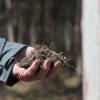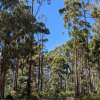
Forest leaders hone skills in sustainable native regrowth management
Posted 07 November 2024
Native regrowth forest management PFT
The latest batch of forest industry leaders were put to the test last week during the Forest Practices Authority's 2024 Forest Practices for Supervisors Course.
The latest batch of forest industry leaders were put to the test last week during the Forest Practices Authority's 2024 Forest Practices for Supervisors Course.
Private Forests Tasmania Operations Manager Jarrod Burn delivered a module on native regrowth forest silviculture, the art and science of sustainably managing the establishment, growth, health and quality forests for this year's students.
Mr Burn said the course was an essential part for forest practices supervisors to understand decisions on appropriate silvicultural treatments such as natural and assisted regeneration practices, thinning for ecological or commercial benefits, timber harvesting practices and pest and disease control practices.
"The module gave understanding of the principles of silvicultural systems and how they derived and applied in the Tasmanian practices system," he said.
"There are a number of recognised and documented silvicultural regimes which have been developed for specific forest types and situations.
"Silvicultural objectives can be developed with a focus on timber production, forest health, ecosystem services and other values which are important to the landowner."
A silvicultural system requires:
- A management objective
- A harvesting system
- A regeneration treatment
- Monitoring and protection
"Tasmania’s extensive native regrowth forests have a long history of active management for timber production," Mr burn said.
"Up to 306,000 hectares of private native forests in Tasmania can be managed sustainably to produce timber, which can contribute significantly to Australia’s timber shortage, support ecosystem and forest health, and produce positive outcomes."
Positive outcomes include:
- Timber products – logs harvested can be sold to domestic and export markets, and are increasingly used in higher value wood products
- Non-timber products – native regrowth forest management enables the production of non-timber products such as honey
- Values and functions – regional employment, recreation, carbon sequestration and ecosystem services are supported by private native regrowth forest management.
Mr Burn said choosing the most appropriate silvicultural regime requires a good understanding of forest growth dynamics and the factors that influence these dynamics.
The practice of silviculture can be described as the employment of techniques to alter the structure of forest and stand to achieve specific management objectives such as:
- Removal of trees so that competition between trees is reduced and growth is encouraged.
- Removal of damaged or undesirable trees or other vegetation components.
- Changing the forest structure to promote desirable values (timber, biodiversity etc.).
- Encouraging the regeneration of desirable species and forest structure.
In native forests, silvicultural techniques are focused on harvesting strategies and regeneration practices, but can also include the use of fire, thinning and other interventions.
"Tasmania has vast native forest cover, much of which is on private land. Native regrowth forests can be actively managed for multiple benefits," Mr Burn said.
"With active management, you can improve the health of your native forest and its ecosystem functions. You can also produce highly valued timber and non-timber products.
"Activities like selective harvesting give the forest's remaining trees more light, water and nutrients. This means they are healthier and more productive for functions such as carbon sequestration. It also means the forest is less vulnerable to pests, disease and fire."
Private Forests Tasmania has a host of resources about private native regrowth forest management here.











